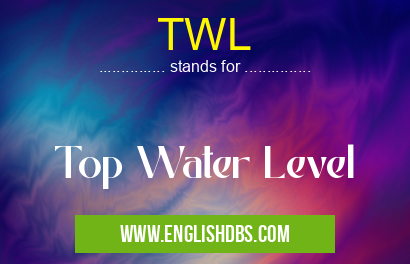What does TWL mean in HYDROLOGY
In the field of Science, TWL stands for Top Water Level. It is a term used to describe the point at which water is contained in an area. This might be in a natural body or large catchment area, man-made reservoir, or other enclosed water-containing areas. It is usually used as reference when discussing the level of water stored in such areas. TWL measures the maximum possible height of water that could fill up a container at any given moment.

TWL meaning in Hydrology in Academic & Science
TWL mostly used in an acronym Hydrology in Category Academic & Science that means Top Water Level
Shorthand: TWL,
Full Form: Top Water Level
For more information of "Top Water Level", see the section below.
Definition
TWL stands for Top Water Level which is defined as the maximum possible height of water that can be contained within a space or container. It is normally expressed as either an absolute reference point or relative to ground level depending on use case. The top water level typically refers to the liquid surface elevation at which a man-made reservoir, natural lake, or other aquatic contained area can reach its maximum capacity and pose safety risks if changes occur outside known parameters.
Applications
TWL has multiple applications and is commonly used by engineers, scientists, and planners when studying fluid dynamics and watersheds. It may also be used to measure stream flow levels during floods, evaluate potential damage from landslides, analyze river erosion patterns over time, assess groundwater storage capacities in aquifers, track desalination operations and reservoirs around the world, and monitor climate change impacts on fragile habitats like coastal wetlands. TWL can also help identify potential hazards related to dam failure or infrastructure collapse due to elevated water levels above design specifications and serve as an anchor point for urban planning efforts involving waterfront structures like docks and marinas.
Essential Questions and Answers on Top Water Level in "SCIENCE»HYDROLOGY"
What is TWL?
TWL stands for Top Water Level. It is the highest water level in a body of water and indicates the maximum elevation or volume of water present in the area.
How does TWL impact aquatic life?
Knowledge about TWL can be important information for determining changes to aquatic ecosystems. They can indicate if there has been an increase or decrease in the water levels, and how this may have impacted the habitats available to species living in or around it.
What are the signs that indicate high TWL?
There are several physical indicators of high TWL. These include larger shoreline areas, increased flooding, higher wave heights, increased erosion, and changes to biodiversity due to altered habitats.
What are the benefits of measuring TWL?
Measuring TWL can provide useful information about local environment conditions and help with predicting potential problems such as floods or droughts. Monitoring of these levels can also alert authorities of any unexpected changes and give them a better understanding of their effects on ecosystems. Additionally, it can provide vital data to develop effective management plans for protecting local wildlife populations.
How is TWL measured?
Typically, measuring devices called gauges are used to measure top water levels. These gauges consist of a float attached to a rod that measures depth when lowered into a body of water. The measurements from these devices enable scientists to measure changes over time accurately and reliably.
Can human activities affect TWL?
Human activities such as construction and agriculture can certainly affect top water levels by reducing natural absorption points for runoff, promoting erosion, introducing pollutants into waterways, and lowering groundwater tables through excessive use or diversion.
Are there any implications associated with rising or fallingTWLs?
Rising or falling top water levels can have serious environmental implications ranging from changes to habitats which can affect species diversity all the way up to more global issues such as sea-level rise due to climate change impacts on sea ice cover melting away faster than normal.
Final Words:
TWL stands for Top Water Level which plays an important role in properly managing aquatic resources including lakes, rivers, reservoirs, estuaries, groundwater systems and more. In addition to providing data about current conditions for environmental protection efforts such as flood forecasting models and assessing sensitive ecosystems like wetlands; it helps inform decisions related to land use regulation responsible development practices while ensuring safe operation of key infrastructure assets across vast stretches of world's most important waterways.
